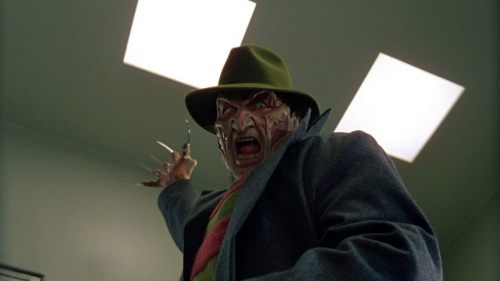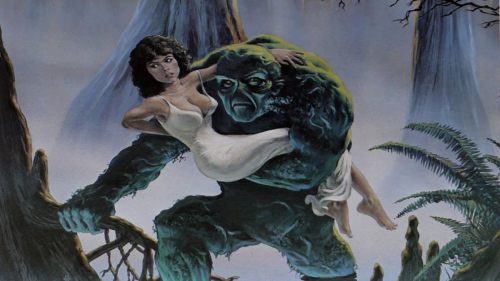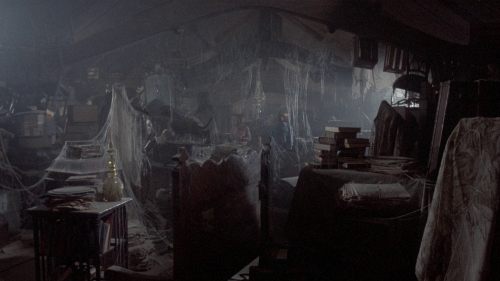Everybody’s Into Weirdness: DEADLY FRIEND (1986)
The Alamo Drafthouse is a brand built on weird. Beyond being situated in a town that has long aspired to remain eccentric in the face of all normality, it’s easy to forget that the original Alamo started as something of a private screening club, running prints of the odd and obscure into all hours of the night. Though the company has obviously grown into an internationally recognized chain of first run movie palaces, the Drafthouse Ritz in Austin, Texas remains committed to showcasing genre repertory programming, namely via its Terror Tuesday and Weird Wednesday showcases. This column is a concentrated effort to keep that spirit of strangeness alive, as programmers Joe A. Ziemba and Laird Jimenez (often pulling from the extensive AGFA archives) are truly doing Satan’s bidding by bringing ATX weekly doses of delightful trash art.
The twenty-second entry into this disreputable canon is Wes Craven’s teenage Frankenstein tale of robot zombie love, Deadly Friend…
Year: 1986
Trailers: A Nightmare on Elm Street; Deadly Blessing
The unfortunate passing of Wes Craven generated much discussion regarding the horror maven’s body of work – a filmography that doesn’t lend itself to unchallenged appreciation. While Craven no doubt changed the genre game during three separate decades (Last House on the Left; A Nightmare on Elm Street; Scream), the tremors that rippled out between those world-shattering quakes were tough to feel without distinct qualifiers. Though the director undoubtedly was able to inject pieces of himself into every slice of mayhem he helmed (even dreck like Deadly Blessing is made more interesting once Craven’s Baptist upbringing is taken into account), that didn’t instantly render those films any easier to sit through. However, none of the “bad” movies that pepper the director’s resume are as idiosyncratically fascinating as Deadly Friend; a 1986 delve in robot slaughter tomfoolery. Near ruined by studio tampering, the picture plays like Craven’s Douglas Sirk riff – a winking ode to the repressed urges of suburban teenagers, punctuated by forced-upon moments of ostentatious horror showmanship.
Deadly Friend is the tale of teen savant, Paul (Matthew Labyorteaux – channeling Keith Gordon’s cute BDP clone from Dressed to Kill), and his blossoming romance with the prototypical “girl next door”, Sam (Kristy Swanson). Unfortunately, Sam’s kept under lock and key by her alcoholic father (Richard Marcus) – a raging deviant who has no problem sneaking into his daughter’s room during the dead of night. This is a suburban oasis, crafted by an artist who knew the horrors it’s idyllic veneer hides all too well. Craven is yet again tapping into his own background as a subjugated youth – guarded every hour of the day by a raging zealot of a mother who wouldn’t allow film, TV or rock ‘n’ roll into her Nowheresville, USA home. Adults can effortlessly mangle the children they’re supposed to nurture, and Craven uses this first hand knowledge to his advantage. Only instead of projecting a post-Vietnam primal howl as he did with Last House on the Left, there’s a self-aware sense of silliness that runs concurrent to the director’s demonic streak, allowing for a perverse, chuckling tonal dissonance to permeate every frame.
Wes Craven was in a tough spot when he made Deadly Friend; a commercial rock and hard place scenario that somewhat forced him to sign onto a project he wasn’t 100% keen on taking to begin with. Though Craven counted himself as a fan of author Diana Henstell’s sci-fi novel Friend, the now notorious Nightmare on Elm Street director also knew that the studio wasn’t exactly on board with his original intentions for the property. Craven hoped to translate the text’s tragic love story and character-focused drama, while simultaneously keeping its dark sci-fi elements intact. However, his previous film (the absolutely atrocious sequel The Hills Have Eyes Part II -- actually shot before Nightmare and completed following its success) burned up whatever goodwill Freddy Krueger had earned him (Hollywood can have such a short memory). Craven needed a rebound, and he saw the WB-financed piece of palatable pop YA fiction as a mode to get back in the good graces of both audiences and checkbook-toting suits.
That didn’t happen. Warner Bros. panicked after early test-screening audiences demanded more of the bloody same from the horror nut. Where was the gore? Where was the iconic killer? What was this teen drama bullshit? Is that subtext I see? Without one thought given to the artist’s desire to push himself outside of his usual wheelhouse, the studio demanded Craven supplement his film with ludicrous amounts of silly carnage. For horror fans, this mandate resulted in the movie’s most viscerally grotesque moments. A dream sequence where blood coats Sam after she impales her abusive father with a broken lamp was added. A coda that runs perpendicular to the rest of the picture features a robot pushing its way out of a corpse. And who can forget a basketball being wielded like an orange projectile from hell, smashing its way through an old woman’s face? Suddenly, this PG-rated traipse down an alley of doomed love was more akin to an X-rated Skipp & Spector splatterpunk joint; guts galore while Craven’s original ideas peek through the grue-coated cracks.
From the outset, Craven is going big and broad, as Paul Conway and his mother, Jeanie (Anne Twomey), move into their new, picture perfect home. Only it seems as if the neighborhood they’ve chosen for relocation is situated in a dimension that’s merely analogous to our own – the architecture of this borough combining Better Homes & Gardens with an almost Southern Gothic mystique (one house has massive white columns stretching to the roof!). Though it’s certainly jarring when BB – the bumble bee yellow robot Paul has somehow constructed all on his own – is escorted down a metal ramp from the Conway’s VW van, he still feels oddly in step with this anti-reality. Spitting Pig Latin (via a voice provided by Roger Rabbit himself, Charles Fleischer) the AI oddity tosses outlet-hiding pianos aside in order to juice his own batteries, all while Paul and Jeanie smile at the bot like he’s the adorable family dog. This is All That Heaven Allows with R2D2’s cognitively impaired cousin standing in for Rock Hudson, and just as Sirk asks you to indulge in his verbose, Technicolor melodrama, Craven expects you to either fall into this audacious world, or get left behind by its emotive bombast.
For those willing to give themselves over to this cartoon universe, there’s a gold mine’s worth of endearing elements. When Paul first meets Sam, Charles Bernstein’s score swells and sparkles, unafraid to tug at your soul like some sort of silver screen after school special. Deadly Friend doesn’t just wear its heart on its sleeve; it tears it out of its own chest and holds it up for you to taste and touch. When a group of dirt bike-riding jabronis start harassing Paul and his new best friend – airhead paperboy extraordinaire, Tom (Michael Sharrett, the blonde bombshell child actor from The Magic of Lassie) – you want to cheer when BB grabs their leader by the dick and hoists him up into the air. Our heroes are stock characters who’ve learned to live via numerous hours of Sesame Street and Mr. Rogers’ Neighborhood – innocent avatars for how we idealize kids’ formative years. So when the crazy coot (Anne Ramsey) who lives in the fortress down the block blows BB away with a shotgun, our world comes crashing down along with Paul’s. How could anyone callously steal incorruptibility away with only a few shells and a smirk?
This agony doubles during Sam’s death. Craven’s lens is so in love with Swanson’s angelic countenance that we can’t help but see her completely through Paul’s eyes. We suddenly hate everything about the world and would do anything to get our best friend back. But the malevolence that festers underneath the picture’s pristine gloss is also what makes you wonder if Craven ever should’ve attempted to make a PG-rated family film. As interested as he is in crafting a world of fleeting love and manicured lawns, the man who filmed one of the most brutal cinematic depictions of sexual violence in Last House on the Left can’t help but inject a level of darkness that’s always threatening to boil over. When Paul decides to save Sam by implanting BB’s brain into her failed cortex, he does so by drugging his own mother, stealing Sam’s corpse, and then keeping her in a shed like some sort of derelict animal. Sam’s now a pet zombie, possessed by a boy who sees her as a thing, not a person; her synthetic mind grasping at memories of all who did her wrong during mortal existence. Deadly Friend retains its aesthetic brightness (until the shadowy, incongruent police shoot out finale), but the golden aura is gone completely. We’re back in the suburbs as Craven sees them – a cesspool of mad people, barely keeping their masks of normalcy in place.
For those looking to poke holes in a picture’s narrative fabric, Deadly Friend will provide a plethora of opportunities. Ditto the movie’s impossible-to-pin-down tone. Is the film super corny – to the point of alienating most who sit down with it? Absolutely. But for those willing to indulge the movie’s saccharine view of teenage existence, there’s a weird amount of emotional truth to be extracted. Despite the copious amount of studio fuckery and tacked-on gore, Deadly Friend is distinctly the work of Wes Craven – an artist fascinated by repression and the horrible evils adults force upon their children. It’s a movie that proves you need to move beyond the big titles and look to a director’s deep cuts in order to truly understand their essence. There’s beauty to be found in the “bad” spots of a famed filmography, and Deadly Friend is far more deserving of praise than its putrid reputation would have you believe.
This Week at Weird Wednesday: Don’t Look In the Basement
Previous WW Features: Penitentiary; Skatetown USA; Blood Games; The Last Match; Invasion of the Bee Girls; Julie Darling; Shanty Tramp; Coffy; Lady Terminator; Day of the Dead; The Kentucky Fried Movie; Gone With the Pope; Fright Night; Aliens; Future-Kill; Ladies and Gentlemen…The Fabulous Stains; Pieces; Last House on the Left; Pink Flamingos; In the Mouth of Madness; Evilspeak



